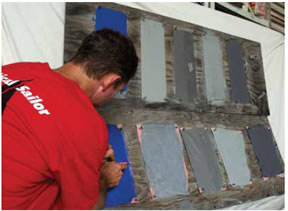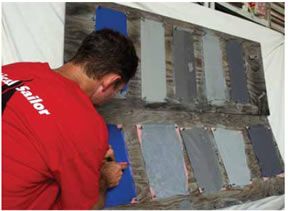
Durability and elasticity are our principal comparative factors in this test, but testers also considered ease of application, coating adhesion to substrate, resistance to abrasion, and price.
In the summer of 2010, Practical Sailor applied each paint per manufacturer’s instructions to patches of Hypalon and PVC inflatable material. Each test patch was assigned a number to ensure blind ratings.
The 10- by 14-inch PVC panels were cut from an 18-year-old, 9-foot Achilles Redline Hypalon dinghy that had been damaged beyond repair. Unable to locate a weathered PVC dinghy to cut up, testers acquired sheets of new PVC from a local inflatable repair shop.
All of the paint makers emphasize that the surface area of the inflatable must be cleaned and prepped properly before applying any primer or paint. All also suggest two coats.
For this test, we roughed up half of each panel with 80-grit sandpaper prior to application to see whether this prep scuffing would help the paint to adhere better. The patches then were cleaned with Nautical Ease, PS’s Budget Buy in our March 2008 test of inflatable boat cleaners.
The testers applied the paints with foam brushes; bristle brushes have a tendency to leave brush marks in the thick, fast-drying paints. We caution anyone working with these products to read all of the instructions carefully. Work outdoors, and wear safety gear. It’s best to work in temperatures above 70 degrees and in low humidity for proper curing.
PS testers rated each panel’s initial appearance and the appearance after 30 days of drying and curing. They were subjected to folding, bending, and hand stretching after the cure time, but none of the panels showed any signs of cracking. To determine the paints’ abrasion resistance, testers dragged a weighted 320-grit sanding block across each panel three times. Paints that showed very little or no scuffing earned the best ratings, and those that showed considerable scuffing were rated Poor.
To determine how well the paints adhered to the substrate, testers cut thin crosshatches in the coating with a knife. Tape was placed over the cuts and pulled. We used a pass/fail rating for this test. If any of the coating stuck the tape, the paint was given a “fail.”
Post bench-testing, the 10 test panels were affixed to plywood sheets and mounted in a sunny spot outside of Practical Sailor’s workshop in Sarasota, Fla. Testers sprayed the panels periodically with salt water over the following 12 months. After one year, the panels were taken down, and testers repeated the initial bench tests to see how the coatings fared after months of exposure to the Florida sun.






































